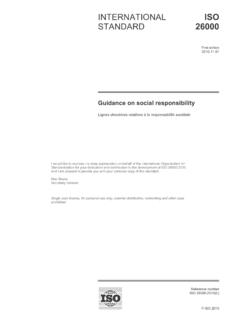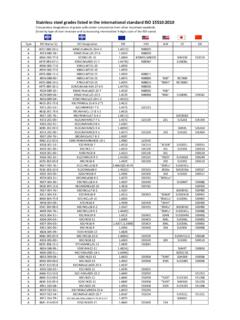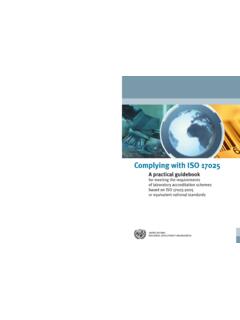Transcription of INTERNATIONAL ISO STANDARD 16750-5
1 Reference numberISO 16750-5 : 2010 (E) ISO 2010 INTERNATIONAL STANDARD ISO16750-5 Second edition2010-04-15 Road vehicles Environmental conditions and testing for electrical and electronic equipment Part 5: Chemical loads V hicules routiers Sp cifications d'environnement et essais de l' quipement lectrique et lectronique Partie 5: Contraintes chimiques ISO 16750-5 : 2010 (E) PDF disclaimer This PDF file may contain embedded typefaces. In accordance with Adobe's licensing policy, this file may be printed or viewed but shall not be edited unless the typefaces which are embedded are licensed to and installed on the computer performing the editing. In downloading this file, parties accept therein the responsibility of not infringing Adobe's licensing policy. The ISO Central Secretariat accepts no liability in this area.
2 Adobe is a trademark of Adobe Systems Incorporated. Details of the software products used to create this PDF file can be found in the General Info relative to the file; the PDF-creation parameters were optimized for printing. Every care has been taken to ensure that the file is suitable for use by ISO member bodies. In the unlikely event that a problem relating to it is found, please inform the Central Secretariat at the address given below. COPYRIGHT PROTECTED DOCUMENT ISO 2010 All rights reserved. Unless otherwise specified, no part of this publication may be reproduced or utilized in any form or by any means, electronic or mechanical, including photocopying and microfilm, without permission in writing from either ISO at the address below or ISO's member body in the country of the requester.
3 ISO copyright office Case postale 56 CH-1211 Geneva 20 Tel. + 41 22 749 01 11 Fax + 41 22 749 09 47 E-mail Web Published in Switzerland ii ISO 2010 All rights reserved ISO 16750-5 : 2010 (E) ISO 2010 All rights reserved iii Foreword ISO (the INTERNATIONAL Organization for Standardization) is a worldwide federation of national standards bodies (ISO member bodies). The work of preparing INTERNATIONAL Standards is normally carried out through ISO technical committees. Each member body interested in a subject for which a technical committee has been established has the right to be represented on that committee. INTERNATIONAL organizations, governmental and non-governmental, in liaison with ISO, also take part in the work. ISO collaborates closely with the INTERNATIONAL Electrotechnical Commission (IEC) on all matters of electrotechnical standardization.
4 INTERNATIONAL Standards are drafted in accordance with the rules given in the ISO/IEC Directives, Part 2. The main task of technical committees is to prepare INTERNATIONAL Standards. Draft INTERNATIONAL Standards adopted by the technical committees are circulated to the member bodies for voting. Publication as an INTERNATIONAL STANDARD requires approval by at least 75 % of the member bodies casting a vote. Attention is drawn to the possibility that some of the elements of this document may be the subject of patent rights. ISO shall not be held responsible for identifying any or all such patent rights. ISO 16750-5 was prepared by Technical Committee ISO/TC 22, Road vehicles, Subcommittee SC 3, Electrical and electronic equipment. This second edition cancels and replaces the first edition (ISO 16750-5 :2003), which has been technically revised.
5 ISO 16750 consists of the following parts, under the general title Road vehicles Environmental conditions and testing for electrical and electronic equipment: Part 1: General Part 2: Electrical loads Part 3: Mechanical loads Part 4: Climatic loads Part 5: Chemical loads INTERNATIONAL STANDARD ISO 16750-5 : 2010 (E) ISO 2010 All rights reserved 1 Road vehicles Environmental conditions and testing for electrical and electronic equipment Part 5: Chemical loads 1 Scope This part of ISO 16750 applies to electrical and electronical systems/components for road vehicles. This part of ISO 16750 describes the potential environmental stresses and specifies tests and requirements recommended for the specific mounting location on/in the road vehicle. This part of ISO 16750 describes chemical loads.
6 It is not designed to evaluate whether an electrical/electronic system/component is suitable for performing during continuous contact with an agent, such as a fuel pump immersed continuously in fuel. NOTE Conditions and testing for a continuous contact can be determined from other standards or agreed upon between customer and supplier. 2 Normative references The following referenced documents are indispensable for the application of this document. For dated references, only the edition cited applies. For undated references, the latest edition of the referenced document (including any amendments) applies. ISO 16750-1, Road vehicles Environmental conditions and testing for electrical and electronic equipment Part 1: General ISO 16750-4, Road vehicles Environmental conditions and testing for electrical and electronic equipment Part 4: Climatic loads 3 Terms and definitions For the purposes of this document, the terms and definitions given in ISO 16750-1 apply.
7 4 Tests General Components and associated parts that can come into contact with the specified chemical agents shall be resistant to those agents. The components and associated parts shall be tested with all agents they are likely to come into contact with, except for those materials which can be shown by documentary evidence to be immune to the contaminant and which need not be tested. A material is considered to be immune to a contaminant if there is no change in properties sufficient to affect material performances over the time and at the temperature specified in this clause. ISO 16750-5 : 2010 (E) 2 ISO 2010 All rights reserved Manufacturer and type of chemical agents shall be agreed upon between supplier and vehicle manufacturer. Resistance to the specified chemical agents shall be considered as early as during the material selection process.
8 Purpose The purpose of the test is to determine whether the device under test (DUT) is unacceptably affected by temporary exposure to contaminating agents. NOTE This test is not intended to be a life test. General test conditions Chemical agents shall be selected in accordance with Table 1, depending on the mounting location of the DUT. Unless otherwise specified, one DUT per test agent shall be used. The DUTs shall be tested with all agents they are likely to come into contact with, except for those materials which can be shown by documentary evidence to be immune to the contaminant and which need not be tested. The following tests describe one test cycle. Unless otherwise specified, one test cycle with one agent per DUT shall be performed. Any other number of cycles may be agreed between customer and supplier.
9 NOTE If the size of the DUT is sufficient, multiple test agents can be applied partially on one DUT if it is ensured that these do not have any influence on each other. DUT conditioning Unless otherwise specified, the DUT shall be stored at a room temperature (RT) of (23 5) C and a relative humidity (RH) of between 25 % and 75 % until temperature and humidity are stabilized. The DUT shall be tested under conditions of normal use. If necessary, and unless otherwise specified, unrepresentative coatings or contaminations of the DUT shall be removed. If a cleaning procedure is needed, the methodology shall be agreed between customer and supplier. Test agent conditioning Unless otherwise specified, all test agents shall be stabilized at an RT of (23 5) C when applied on the DUT. Application method Unless otherwise specified, application shall be performed at an RT of (23 5) C and an RH of between 45 % and 75 %.
10 It shall be ensured by the choice of the application method that the DUT is sufficiently wetted by the test agent in the areas to be tested. The application method shall be chosen in accordance with Table 2, depending on the agent and the mounting location of the DUT. The preferred application methods are given in Table 1. Test conditions Unless otherwise specified, the exposure of the DUT to the agent applied shall be performed at the temperature and for the duration specified in Table 1. ISO 16750-5 : 2010 (E) ISO 2010 All rights reserved 3 Table 1 Chemical loads for equipment depending on the mounting location and test conditions Mounting location [code]a Exposure conditions Engine compartment Passenger compartmentLuggage compartmentMounting on the exterior Other require-ments Test tempe-rature ID Chemical agents [A]b [B]b [C]b [D]b [Z]










